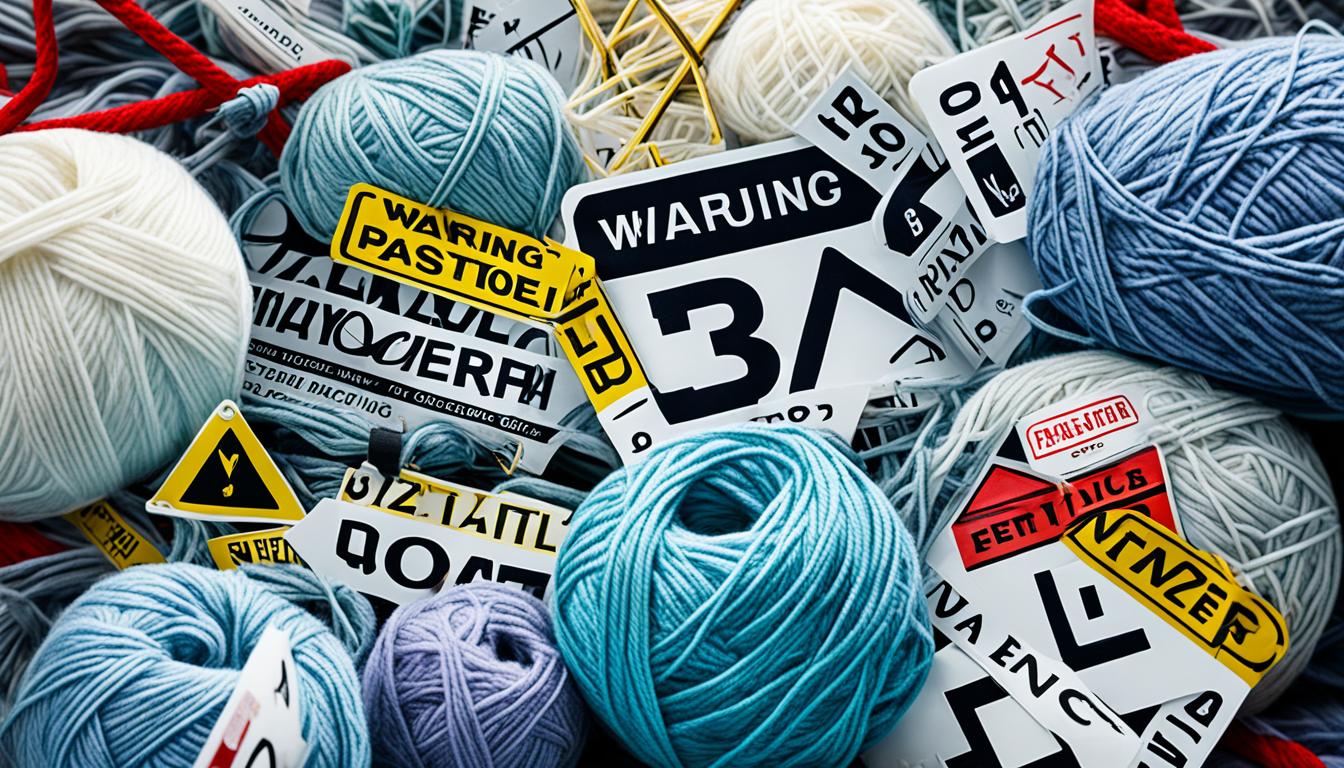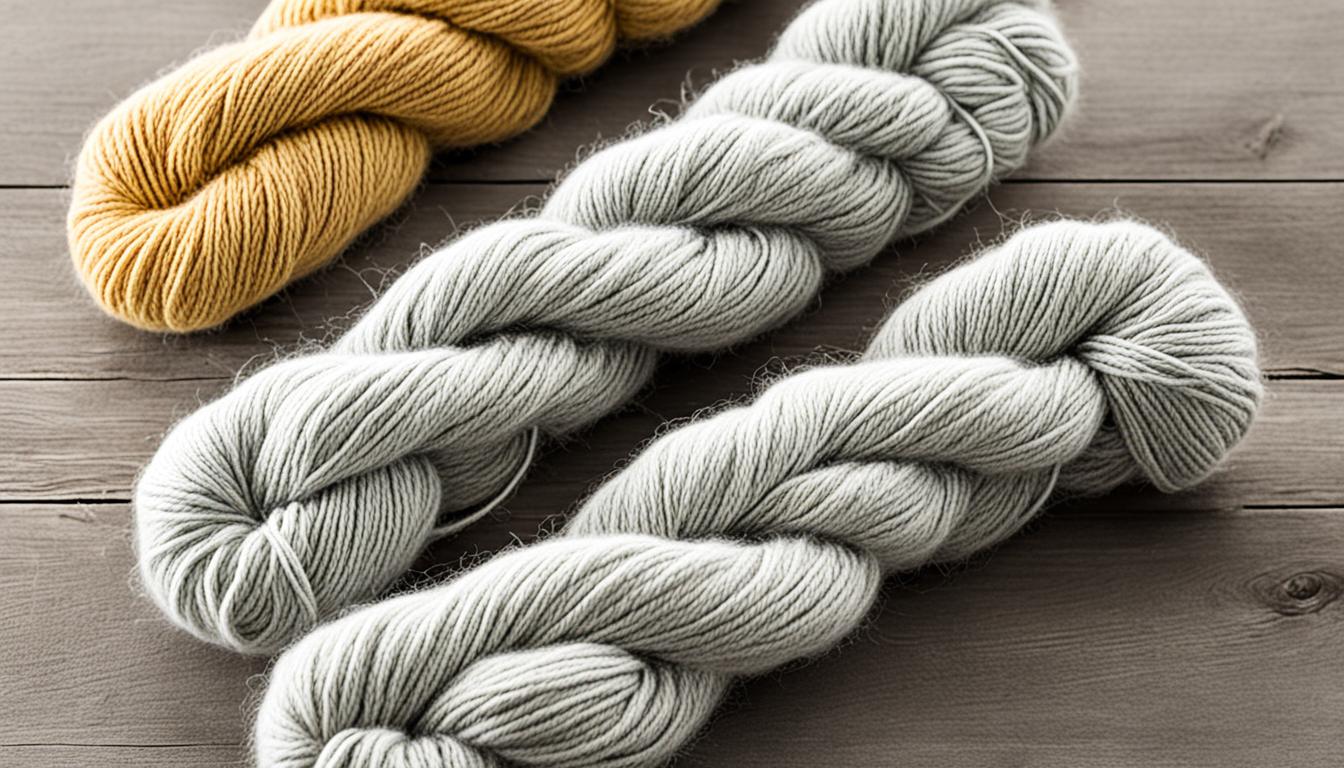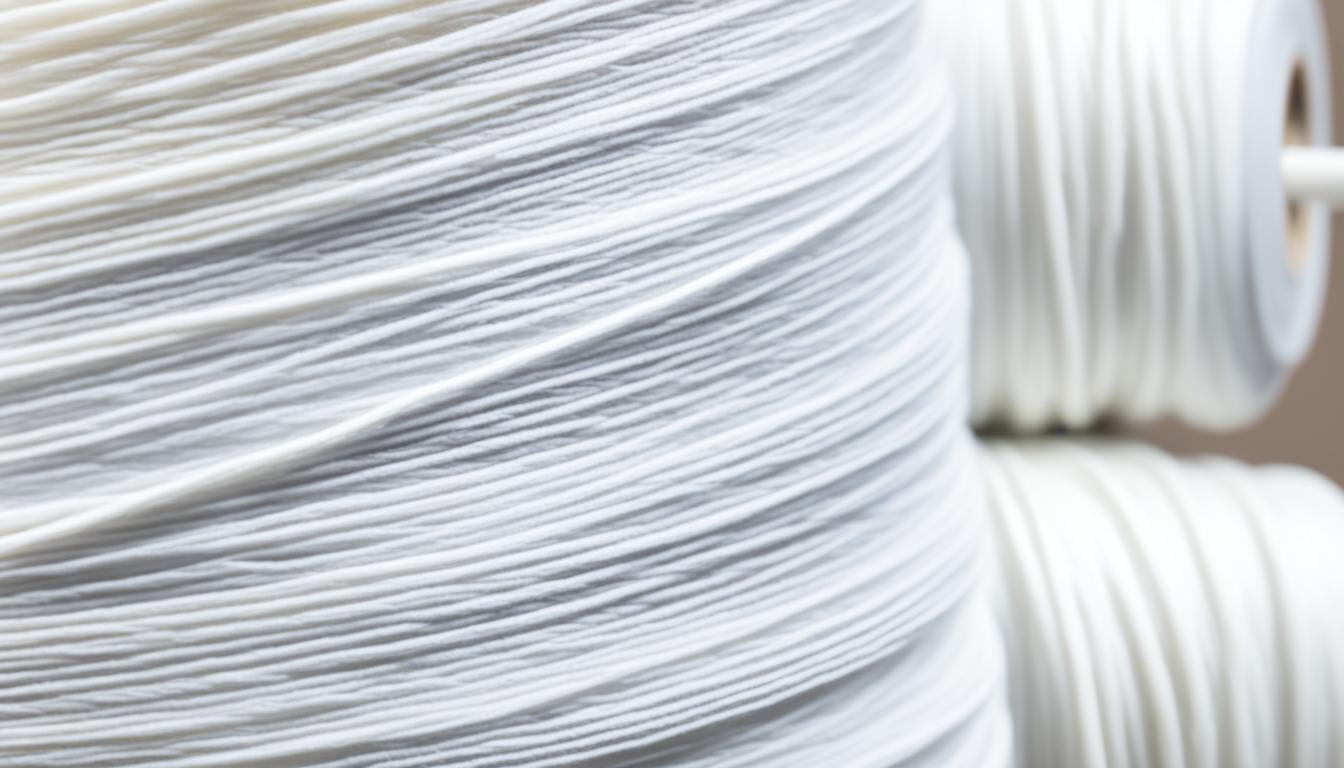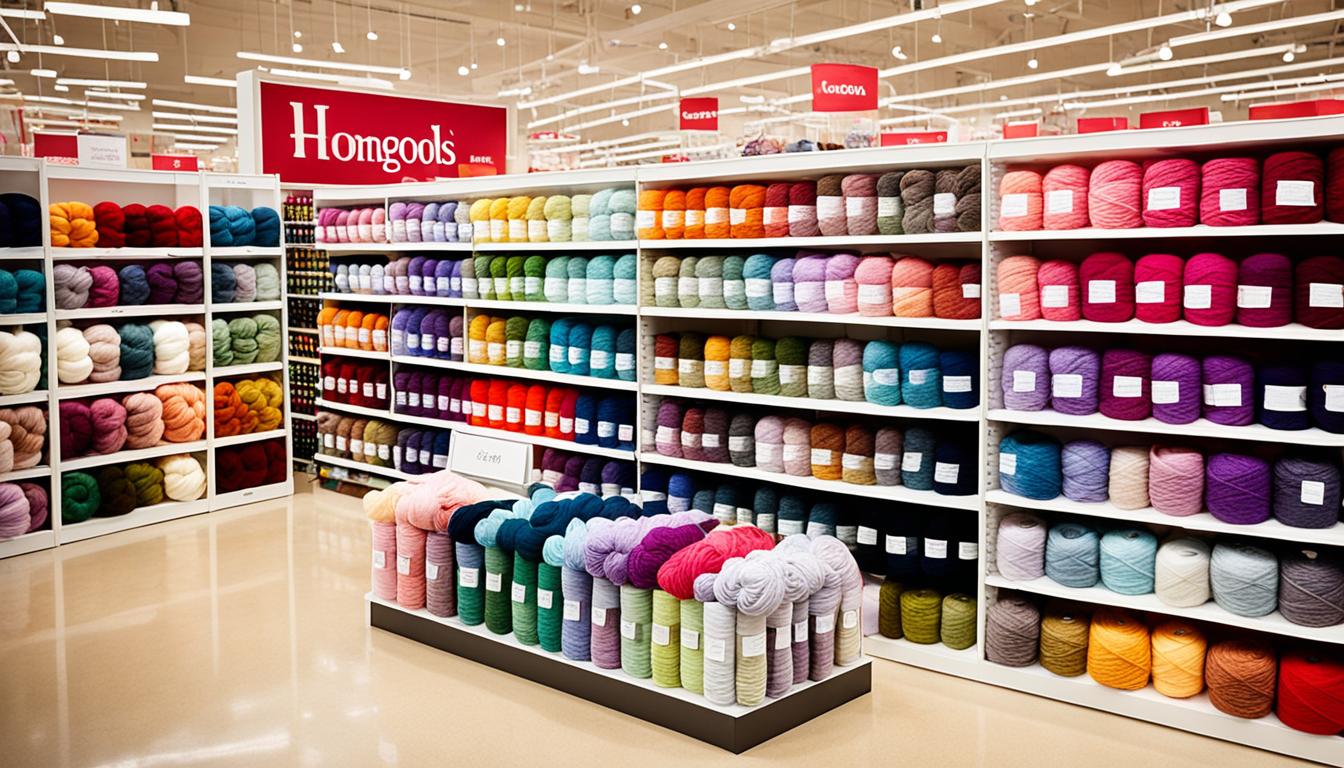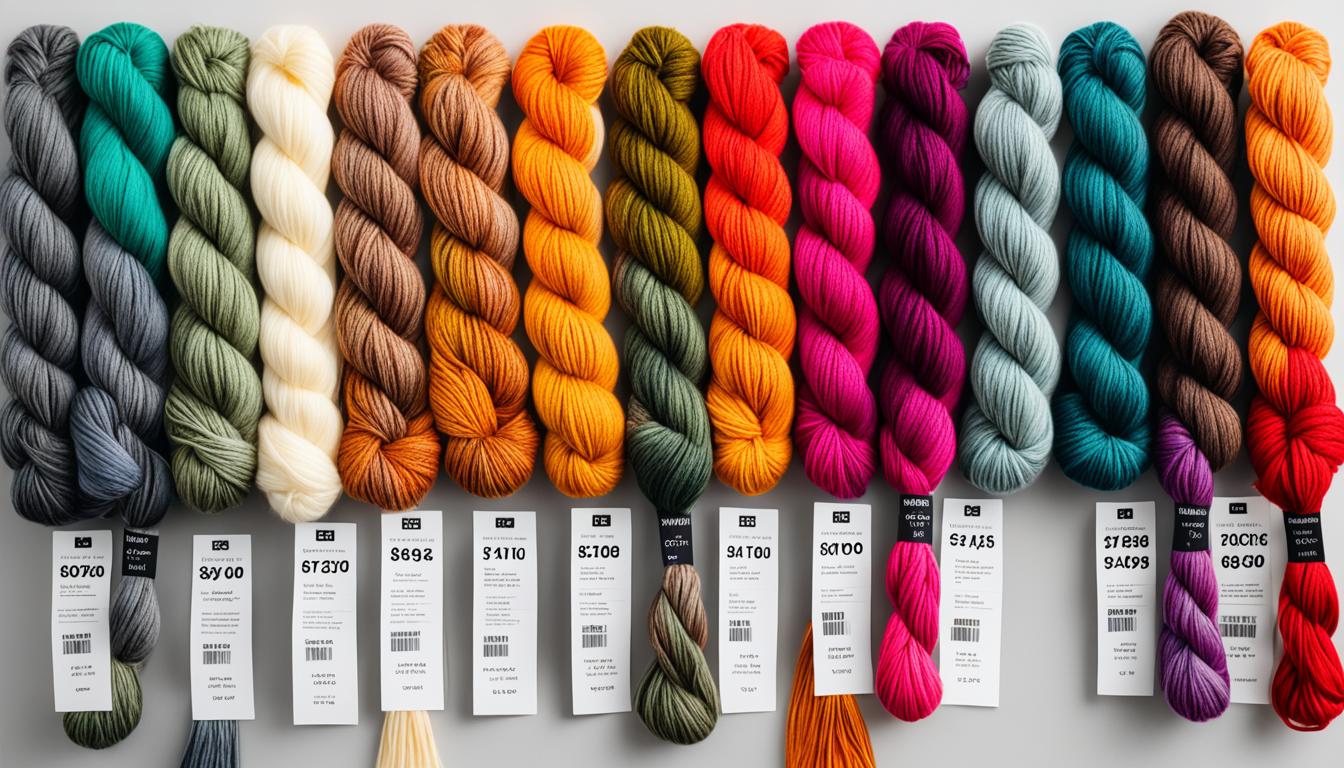Acrylic yarn is a popular choice for crafters and knitters due to its affordability and versatility. But have you ever wondered about the potential risks and safety concerns associated with using acrylic yarn for your projects? Are there any health effects or harmful chemicals that you should be aware of?
In this article, we will explore the safety facts surrounding acrylic yarn, including its potential health hazards and the dangers it may pose to you and the environment. We will delve into the production process, examine the chemicals used, and discuss the impact on human health. Additionally, we will explore the environmental implications of acrylic yarn and provide you with alternative options that are safer and more sustainable.
So, if you’re curious about the safety of acrylic yarn and want to make informed choices for your crafting projects, keep reading to uncover the truth behind this widely-used material.
Key Takeaways:
- Acrylic yarn is a popular choice for crafters due to its affordability and versatility.
- The production of acrylic yarn involves the use of hazardous chemicals that can have detrimental effects on human health.
- Acrylic yarn poses environmental risks due to its production process and lack of biodegradability.
- There are alternative options available that are safer and more sustainable.
- By understanding the potential risks and exploring alternatives, you can make informed choices for your crafting projects.
Potential Health Risks of Acrylic Fabric
The production of acrylic fabric involves the use of toxic chemicals such as formaldehyde, phthalates, and chlorine. These chemicals are known to have adverse health effects. Acrylic fabric is also treated with flame retardants, which have been linked to cancers, thyroid issues, and neurodevelopmental problems.
While the levels of chemicals present on acrylic clothing at the consumer stage may not directly cause cancer, they are still treated and created with known carcinogenic substances. Acrylic clothing can also have negative effects on children, as their developing bodies and brains are more susceptible to the adverse health effects of flame retardants.
Additionally, acrylic clothing is not breathable, which can lead to skin irritations, rashes, and exacerbation of issues such as acne and dermatitis.
Environmental Impacts of Acrylic Fabric
Acrylic fabric has significant environmental impacts. Its production relies on fossil fuels, with approximately 70 million barrels of oil used each year to produce synthetic fibers like acrylic. This heavy reliance on fossil fuels contributes to carbon emissions and the depletion of finite resources.
One of the key environmental concerns with acrylic fabric is its non-biodegradability. Unlike natural fibers such as cotton or wool, acrylic fabric does not break down easily. It can persist in the environment for hundreds of years, occupying valuable landfill space.
The non-biodegradability of acrylic fabric also leads to another significant environmental issue: microplastic pollution. When acrylic clothing is discarded and ends up in landfills or is washed, it releases tiny plastic particles called microplastics. These microplastics contaminate the air, water, and soil, posing a threat to both terrestrial and aquatic ecosystems.

Microplastic pollution from acrylic clothing has become a widespread problem. These tiny particles can be ingested by marine life, potentially entering the food chain and causing harm to animals and humans alike. Additionally, microplastics have been found in various water sources, affecting the quality of drinking water and posing risks to aquatic organisms.
| Environmental Impacts of Acrylic Fabric | Description |
|---|---|
| Heavy reliance on fossil fuels | Approximately 70 million barrels of oil used each year in production. |
| Non-biodegradability | Acrylic fabric does not easily break down and can persist in the environment for centuries. |
| Microplastic pollution | Discarded acrylic clothing releases microplastic particles that contaminate the air, water, soil, and potentially enter the food chain. |
The environmental impacts of acrylic fabric highlight the need for sustainable alternatives and responsible consumption practices. By choosing fabrics made from natural and renewable resources, such as organic cotton, wool, or hemp, we can reduce our reliance on fossil fuels and minimize the pollution associated with non-biodegradable materials.
References:
- “Environmental impacts of textile reuse and recycling—A systematic review.” Journal of Cleaner Production, 2016.
- “Emissions from synthetic textiles as a major microplastic source in the environment.” Scientific Reports, 2017.
Regulations and Restrictions on Acrylic Fabric Chemicals
When it comes to the chemicals used in acrylic fabric production, several regulations and restrictions are in place to ensure the safety of consumers and protect the environment. These regulations aim to control the use of hazardous substances and set limits on their presence in acrylic fabric.
REACH Regulations for Acrylic Fabric
In Europe, the Registration, Evaluation, Authorisation, and Restriction of Chemicals (REACH) regulations play a crucial role in safeguarding people and the environment from toxic substances. These regulations impose strict restrictions on the use of certain chemicals in the production of acrylic fabric, including formaldehyde and acrylonitrile. The European Union (EU) has even gone a step further by prohibiting the sale of items that exceed the set limits for formaldehyde presence in order to protect consumers.
TSCA and EPA Regulations for Acrylic Fabric
In the United States, the Toxic Substances Control Act (TSCA) and the Environmental Protection Agency (EPA) regulate the use of toxic chemicals in various industries, including acrylic fabric production. The TSCA requires clothing made in the USA to undergo testing to ensure they do not contain dangerous levels of toxic substances. The EPA sets limits on formaldehyde residue in acrylic fabric and prohibits the presence of certain chemicals on finished acrylic products, further safeguarding consumers from potential harm.
These regulatory measures help to ensure that acrylic fabric on the market meets certain safety standards and contributes to a safer and healthier environment for everyone.

Regulations and restrictions on acrylic fabric chemicals are essential for protecting both consumers and the environment. The REACH regulations in Europe and the TSCA and EPA regulations in the United States play crucial roles in controlling the use of toxic substances in acrylic fabric production. These measures help prevent the presence of harmful chemicals and ensure that acrylic fabric meets certain safety standards. By adhering to these regulations, manufacturers and consumers can contribute to a safer and healthier future.
Less Toxic Alternatives to Acrylic Fabric
While acrylic fabric is widely popular, there are many less toxic alternatives available. These sustainable and natural alternatives not only offer similar functionality but also contribute to a more eco-friendly and healthier fashion industry.
Wool

Wool is a fantastic alternative to acrylic fabric. It provides warmth, comfort, and breathability without the use of harmful chemicals. Additionally, wool is a renewable and biodegradable material, making it an environmentally friendly choice.
Cotton
Cotton is another popular and natural alternative to acrylic fabric. It is soft, breathable, and lightweight, making it suitable for various clothing items. Cotton is also biodegradable and can be easily sourced sustainably.
Hemp
Hemp is a versatile and eco-friendly alternative to acrylic fabric. It is known for its durability, breathability, and resistance to wear and tear. Hemp cultivation requires fewer pesticides and water compared to other crops, making it a sustainable choice.
Linen
Linen is a natural fiber that offers similar qualities to acrylic fabric. It is lightweight, absorbent, and breathable, making it ideal for warm weather clothing. Linen is also biodegradable and has a minimal environmental impact.
TENCEL Lyocell
TENCEL Lyocell is a newer material made from eucalyptus trees. It offers a sustainable and non-toxic alternative to acrylic fabric. TENCEL Lyocell is lightweight, absorbent, and wrinkle-resistant, providing comfort and versatility without the use of harmful substances.
When considering alternatives to acrylic fabric, it’s important to choose organic and certified fabrics to ensure their sustainability and safety. By opting for these natural alternatives, you can reduce your environmental footprint and minimize potential health risks associated with acrylic fabric.
Debunking Myths about Acrylic Yarn
There are several myths surrounding acrylic yarn that have contributed to misconceptions about its quality and versatility. Let’s examine these myths and set the record straight.
Myth: Acrylic yarn is itchy and uncomfortable to work with and wear.
This is a common misconception about acrylic yarn. While older versions may have been scratchy, today’s acrylic yarns are soft and comfortable. They are specifically designed to provide a cozy and enjoyable crafting experience.
Myth: Acrylic yarn is undyeable.
Contrary to popular belief, acrylic yarn can be dyed using acid dyes. Acid dyes are suitable for synthetic fibers like acrylic and can create vibrant and long-lasting colors. So, if you’re looking to add a personal touch to your acrylic project, go ahead and experiment with dyeing!
Myth: Acrylic yarn doesn’t felt.
While it’s true that acrylic yarn doesn’t felt as easily as natural fibers like wool, it is still possible to achieve felting with the right techniques. By using a combination of hot water, agitation, and some soap, you can create a felted effect with acrylic yarn.
Myth: Acrylic finished objects (FOs) cannot be blocked.
This is not true. Acrylic FOs can indeed be blocked, giving them a more polished and professional finish. Steam blocking or wet blocking methods can be used to shape and resize acrylic projects to your desired specifications.
Myth: Acrylic yarn pills easily.
While it’s true that some lower-quality acrylic yarns may be prone to pilling, this is not a blanket statement for all acrylic yarns. Higher-quality acrylic yarns, especially those with tighter twists, are less likely to pill. Additionally, proper care and maintenance can help minimize pilling.
It’s important to remember that not all myths are grounded in truth. Acrylic yarn has come a long way in terms of its quality and versatility, making it a viable option for crafters of all skill levels. Don’t let these misconceptions deter you from exploring the unique possibilities that acrylic yarn offers!
Characteristics and Uses of Acrylic Fabric
Acrylic fabric is known for its versatility and a range of desirable characteristics that make it a popular choice in various applications. Whether it’s clothing, bedding, outdoor gear, or upholstery, acrylic fabric offers several benefits that make it an attractive option.
One of the key characteristics of acrylic fabric is its sturdiness and durability. It is resistant to damage from the sun, allowing it to maintain its vibrant colors even with prolonged exposure to UV rays. Additionally, acrylic fabric is highly resistant to mold and mildew, making it suitable for outdoor use and humid environments.
Another advantage of acrylic fabric is its hypoallergenic properties. For individuals with sensitive skin or allergies, acrylic fabric can be a comfortable and safe option. It does not irritate the skin or trigger allergic reactions, making it an excellent choice for individuals with specific sensitivities.
The versatility of acrylic fabric extends to its wide range of uses. In clothing, it is commonly used to create warm and cozy sweaters, scarves, hats, and gloves. Its ability to retain heat and resist moisture makes it ideal for winter garments.
Bedding is another area where acrylic fabric shines. Its softness and durability make it an excellent choice for blankets, throws, and decorative pillows. Acrylic blankets provide warmth and a fluffy texture, perfect for cozy nights or adding a touch of elegance to your home decor.
When it comes to outdoor gear, acrylic fabric offers exceptional performance. It is resistant to fading, allowing outdoor equipment such as tents, awnings, and backpacks to maintain their vibrant colors even in harsh weather conditions. Acrylic fabric is also known for its ability to resist mold and mildew, ensuring the longevity and functionality of outdoor gear.
Upholstery is yet another use for acrylic fabric, thanks to its durability and similarity to natural fibers. It is often used to upholster furniture pieces such as chairs, couches, and ottomans. Acrylic fabric provides a luxurious look and feel without the high maintenance and fragility associated with other materials.
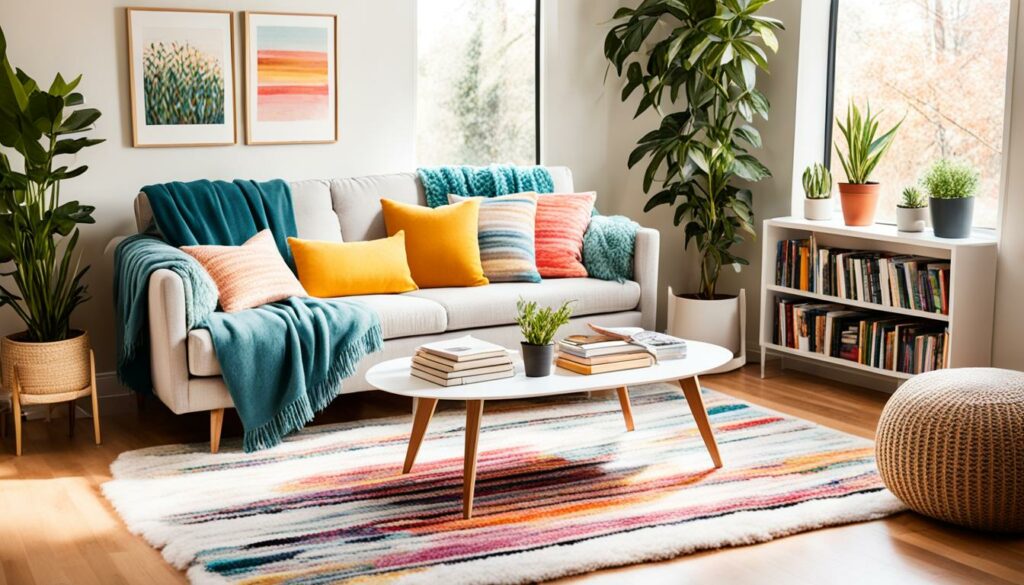
The characteristics and uses of acrylic fabric make it a versatile and reliable choice for various purposes. Whether you’re looking for clothing, bedding, outdoor gear, or upholstery, acrylic fabric offers durability, resistance, and comfort.
Production Process of Acrylic Fabric
Acrylic fabric is created through a complex production process that involves chemical synthesis and various manufacturing techniques.
The production of acrylic fabric begins with acrylonitrile, which is derived from materials like petroleum or coal. Acrylonitrile is then processed to form small pellets called acrylic resin.
Next, the acrylic resin is fed into a spinneret device. The spinneret has small holes through which the acrylic resin is pushed, creating long, continuous fibers. This ensures that the fibers do not break during production.
Once the fibers are formed, they are twisted together to create yarn. This yarn can be used for a variety of purposes, including weaving and knitting acrylic fabric.
The process of weaving involves interlacing the acrylic yarn to form a fabric. This can be done on a loom, where vertical threads called the warp are intertwined with horizontal threads called the weft. Knitting, on the other hand, involves interlocking loops of yarn to create a flexible and stretchable fabric.
Overall, the production process of acrylic fabric combines chemical synthesis with spinning, twisting, weaving, and knitting techniques to create a versatile and durable material.
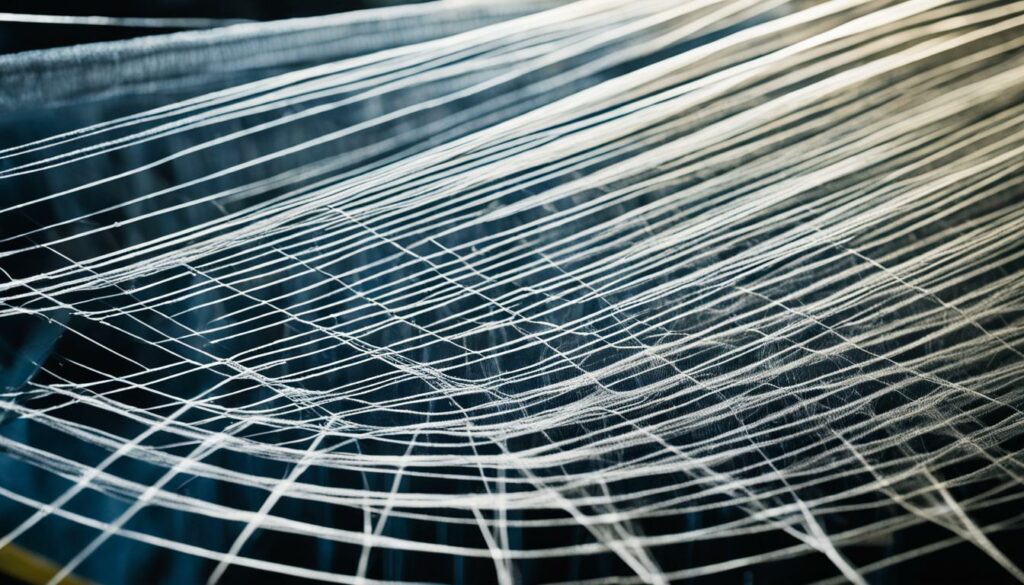
Spinneret in Acrylic Fabric Production
The spinneret device plays a crucial role in the production of acrylic fabric. It is designed to push the acrylic resin through small holes, ensuring the creation of continuous fibers without breakage. This device is crucial for maintaining the integrity and quality of the acrylic fabric.
Types of Acrylic Fabric
Acrylic fabric comes in several different types, each with unique characteristics and uses. Understanding the different types of acrylic fabric can help you choose the right material for your specific needs.
1. Acrylic Fiber
Acrylic fiber is the most common type of acrylic fabric. It closely resembles wool and offers good resistance to acid and sunlight. Acrylic fiber is known for its softness and warmth, making it a popular choice for clothing items like sweaters, scarves, and hats.
2. Modacrylic
Modacrylic is a flame-resistant type of acrylic fabric. It is commonly used in clothing for industries with fire or electrical hazards, such as firefighters’ uniforms and electrical workers’ protective clothing. Modacrylic fabric offers excellent flame resistance without compromising on comfort.
3. Nytril
Nytril is a firm and durable type of acrylic fabric. It is commonly used in applications that require strength, such as ropes, seat belts, and protective clothing. Nytril fabric is known for its resistance to abrasion and tearing, making it ideal for demanding environments.
4. Lastrile
Lastrile is a type of acrylic fabric that is known for its exceptional resistance to fading, shrinkage, and wrinkles. This makes it popular for swimwear, athletic wear, and lingerie, where durability and shape retention are essential. Lastrile fabric offers a versatile and long-lasting option for these types of garments.
Each type of acrylic fabric has its own set of characteristics and uses, allowing you to choose the fabric that best suits your specific requirements. From the softness of acrylic fiber to the flame resistance of modacrylic, acrylic fabric offers a range of options for various applications.
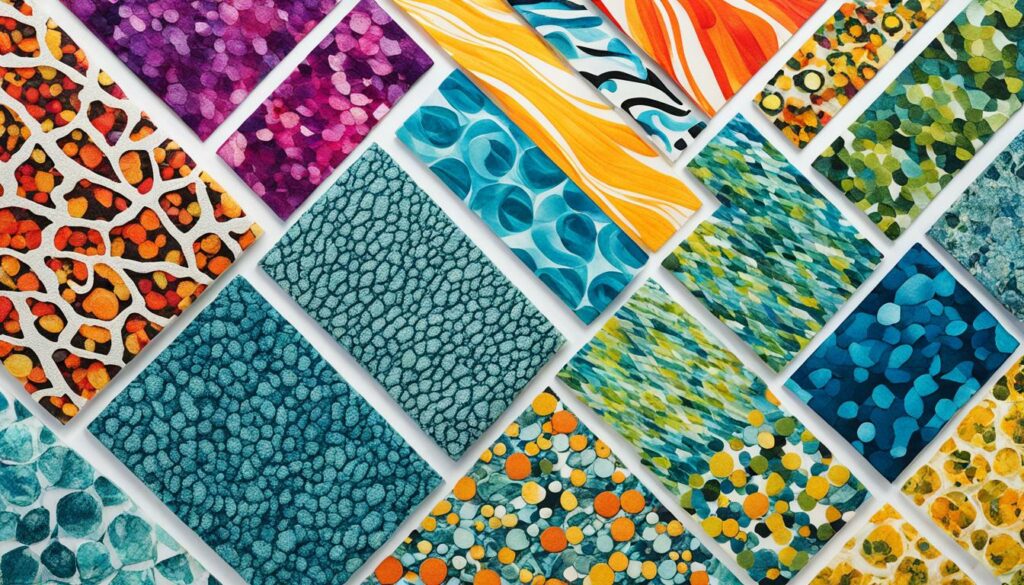
Advantages and Disadvantages of Acrylic Fabric
Acrylic fabric offers several advantages that make it a popular choice for clothing and other applications. First and foremost, acrylic fabric is lightweight, making it comfortable to wear and ideal for garments that require ease of movement. Its low-maintenance nature is another advantage, as acrylic fabric is easy to care for and resistant to wrinkles, shrinking, and stretching.
One of the key benefits of acrylic fabric is its resistance to sunlight and chemicals. Acrylic fibers are known for their durability and ability to withstand prolonged exposure to sunlight without fading or deteriorating. Additionally, acrylic fabric is highly resistant to chemicals, making it a suitable choice for industries or environments where exposure to harsh substances may occur.
Another significant advantage of acrylic fabric is its hypoallergenic properties. It is a synthetic material, which means it is less likely to cause allergic reactions compared to natural fibers like wool or cotton. This makes acrylic fabric a great option for people with sensitive skin or allergies.
“Acrylic fabric is lightweight, low-maintenance, resistant to sunlight and chemicals, and hypoallergenic.”
However, there are also drawbacks to consider when it comes to acrylic fabric. One common issue is pilling, which refers to the formation of small balls of fabric on the surface. While pilling can occur with any type of fabric, acrylic is more prone to this problem compared to natural fibers. Additionally, acrylic fabric is not as breathable as natural fibers, which can lead to discomfort and excessive sweating, especially in hot and humid climates.
It’s important to address the environmental concerns associated with acrylic fabric. Unlike natural fibers, acrylic is not biodegradable and does not break down naturally over time. This means that discarded acrylic fabric contributes to the growing issue of textile waste. Additionally, the production process of acrylic fabric relies on non-renewable fossil fuels, further impacting the environment.
To summarize, acrylic fabric offers advantages such as being lightweight, low-maintenance, resistant to sunlight and chemicals, and hypoallergenic. However, it is important to consider the drawbacks, including pilling, lack of breathability, and environmental concerns. If you prefer a more sustainable and breathable option, exploring alternatives like cotton, wool, or TENCEL Lyocell may be worth considering.
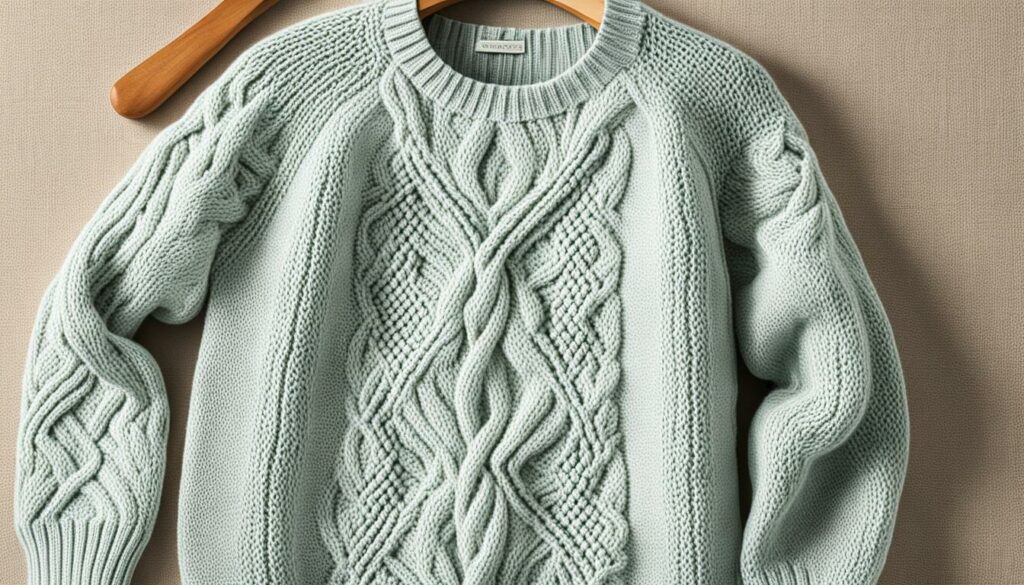
Advantages and Disadvantages of Acrylic Fabric
| Advantages | Disadvantages |
|---|---|
| Lightweight | Pilling |
| Low-maintenance | Lack of breathability |
| Resistance to sunlight and chemicals | Environmental concerns |
| Hypoallergenic |
Conclusion
Acrylic fabric is a widely used material in the fashion industry, known for its versatility and durability. However, it is important to be aware of the potential health and environmental risks associated with acrylic fabric. The production process of acrylic fabric involves the use of hazardous chemicals that can expose individuals to carcinogens and endocrine disruptors. Additionally, acrylic fabric has significant environmental impacts and does not biodegrade, contributing to the global issue of plastic pollution.
While wearing acrylic clothing is unlikely to have severe health impacts, it is worth considering more natural and sustainable alternatives. Wool, cotton, hemp, linen, and TENCEL Lyocell are all great options that offer similar qualities to acrylic fabric without the potential health risks and environmental harm. These alternatives are made from renewable resources, biodegrade naturally, and often involve less chemical treatment in their production.
By choosing these sustainable alternatives, you can reduce your environmental footprint and minimize potential health risks associated with acrylic fabric. Whether it’s clothing, bedding, outdoor gear, or upholstery, there are plenty of options available that prioritize both your well-being and the health of the planet.
